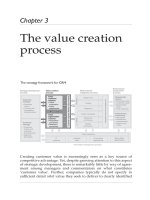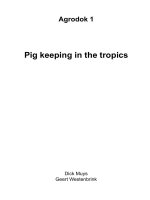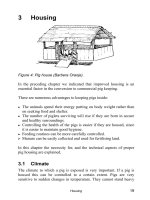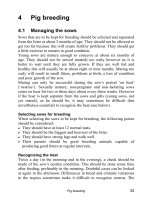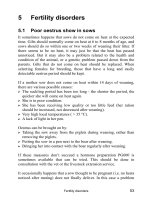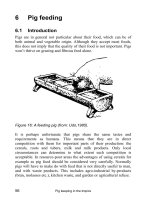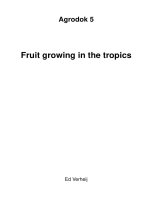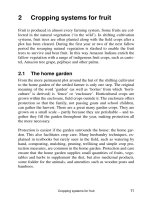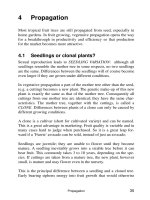Erosion control in the tropics - Part 3 pps
Bạn đang xem bản rút gọn của tài liệu. Xem và tải ngay bản đầy đủ của tài liệu tại đây (165.4 KB, 9 trang )
The erosion process 17
3 The erosion process
Some understanding of the way in which the erosion process takes
place is needed to appreciate the usefulness of preventive measures. A
few factors will be mentioned which together determine how much
and what type of erosion is likely to occur.
3.1 Splash-erosion and stream-erosion
Within water-erosion there are two types of erosion: splash erosion
and stream erosion. Certainly, they do occur at the same time, but for
clarity we will discuss them separately.
Splash erosion
In splash erosion, the falling raindrops break off small parts of the soil
aggregates (see Glossary). The loosened small soil particles fill the
gaps between the larger particles and a so-called crust is formed (see
figure 7). This layer or crust is not easily penetrated by water and air;
Water cannot easily infiltrate in the soil, and is not available to the
plant- roots; hence crop growth is hindered and the water will run-off.
Figure 7: Splash erosion and crusting
In splash erosion, the force of the falling raindrops is determined by
the size and the falling velocity of the raindrop. Both these factors are
of course closely related to the type of rainstorm from which the drop-
lets fall. If the raindrops are first intercepted by a cover crop before
Erosion control in the tropics 18
falling on the soil their impact will be less. Those falling from a
greater height will have more impact.
Stream erosion
Water that cannot penetrate the soil, runs off to lower lying areas,
choosing the path of least resistance. This process causes the danger of
stream erosion. In stream erosion, the particles that were loosened by
the turbulence in the water are carried away by the streaming water
(see figure 8A & B).
Figure 8: Stream erosion
Where the water stream collects, the scouring action of the water is
greater and rills may be formed there. These become bigger through
collapsing of the sidewalls and scouring until a gully of several metres
deep is formed.
The amount of erosion that occurs depends mainly on the force with
which the water acts upon the soil and the degree to which the soil can
resist this force. The scouring force of the run-off depends mainly on
the velocity of the water. The steeper the slope and the deeper the
stream, the faster the water will flow. If the slope at a higher level is
very long, a lot of water can accumulate and the erosive force may
increase even more. The degree in which the soil can resist this force,
is handled in Paragraph 3.2.
The erosion process 19
Combination of splash- and stream erosion
The combined action of splash and stream erosion seems to be much
more serious than the effect they have individually. Erosion caused by
run-off appears to increase considerably when raindrops fall in a water
layer of a few millimetres. The water is churned around as it were,
loosening still more soil particles which are then washed away (see
figure 9).
Figure 9: Combination of splash and stream erosion
3.2 Splash-erosion and soil condition
There obviously is a relation between the type of soil and the suscep-
tibility to erosion. In general the bigger the soil-particles, the greater
the resistance. In steep areas only rocks are found. In less steep areas
stones and course sands are found. Naturally, the more vulnerable
soils are formed on places were the water-force is not strong. These
soils are of interest for agriculture. Man-made circumstances (e.g. de-
forestation), however, can change this.
Looking at the vulnerability of soils: One soil will offer much more
resistance to erosion than the other. This resistance mainly depends
on:
? the organic matter content of the soil.
? the moisture content
? the type and texture, (the mineral particles which compose the soil,
e.g. sand, silt, clay).
Erosion control in the tropics 20
Organic matter content of the soil
Organic matter probably is the most important factor in binding the
soil particles. The better the soil particles stick together, the less easy
erosion will occur. As well as organic materials, clay, lime and iron
will also binds the soil particles together; hence the clods are less eas-
ily broken down by raindrops (see figure 10).
Besides, organic matter is very important for soil fertility and the wa-
ter holding capacity of the soil. The more water can be absorbed, the
less water will run off and cause erosion.
Figure 10: Adhesion of soil particles
Moisture content of the soil
Depending on the soil type, also the moisture content determines the
stability of the soil. Dry soils can be very hard, but because of that, the
water will not easily infiltrate and cause great run-off streams once a
rainstorm occurs. The moisture content of the soil is not the same
throughout the year so at certain times the soil is much more sensitive
to stream-erosion than at other times. The soil should be protected as
much as possible at these vulnerable times.
When dry, some soils are stone hard and difficult to work. They are
then not easily broken up by raindrops. If the moisture content is
higher, these soils are more manageable and the clods sometimes
break up on their own accord. These periods are usually at the begin-
The erosion process 21
ning and at the end of the rainy season when there is no protective
crop cover. If the soil becomes very fine through tillage operations, the
danger of splash-erosion is great. The rain no longer has to break up
the clods first, and the soil particles can be quickly carried away by
the streaming water, after heavy rains.
If the soil is very wet (in a saturated condition), the resistance to ero-
sion often disappears altogether. The top soil layer is completely dis-
rupted. Just before a shower, sizeable clods are apparent in the field
and afterwards the topsoil looks like a muddy pulp, certainly on
clayey soils. Different soil types will react differently. So it is advis-
able to first have a good look around in your surroundings to see how
the various soil types react to a number of rain showers. This gives a
good idea of the resistance of the soil. A simple manipulation test (see
Glossary) is very useful to give an indication of the type of soil con-
cerned.
Type and texture
The type of soil is depends for a great part on the texture: The compo-
sition of the mineral particles of the soil. This can indicate the vulner-
ability. However, since the texture of a soil can not be easily changed,
this does not offer a possibility for controlling erosion and we will not
go into this subject any further.
3.3 Stream erosion and the soil
Stream erosion is the ability of streaming water to loosen soil particles
and carry them away. In some clay soils it is not even necessary for
particles to be loosened, the top layer dissolves, as it were, in the wa-
ter and is transported is suspended load.
The stream velocity needed to transport this clay suspension is almost
nil which can be demonstrated by the length of time it takes before
stagnant water loses its muddy colour after a rain shower and becomes
really clear. For the same reason the very top layer of sediment mate-
rial is always very fine in composition.
Erosion control in the tropics 22
In practice this can result in the field becoming more stony because
the finer particles are slowly washed away. If measures are not taken
in time, enormous damage may result from this often strong carrying
capacity of the water.
Rough soil surface
The faster the water runs, the greater the scouring force of the water.
The stream velocity increases as the resistance for the runoff declines,
that is, for a smooth soil surface. In other words: A rough soil surface
can hold back stream erosion. Obstacles such as plant stalks, stones
and a mulch also offer more resistance to the streaming water.
Stream erosion is best prevented by seeing that the water doesn’t run
off. The streaming water should not be allowed to accumulate either,
because large quantities of water are potentially dangerous.
Water that does not reach the stage of runoff will not be able to cause
stream erosion, but could well be beneficial to plant growth if allowed
to infiltrate into the soil. Much more water will infiltrate into a crum-
bly soil than through a smooth top soil layer. Consider a slight slope
with horizontal furrows. A lot of water can be retained here before it
eventually runs off (see figure 11).
Figure 11: Run off on smooth surface and infiltration in coarse sur-
face
Of course, the infiltration capacity (see Glossary) does not depend
upon just the coarseness of the soil. The soil texture (sand versus
clay), the organic material level and a healthy soil fauna may all en-
The erosion process 23
courage infiltration. In general the role of the soil organisms is too
little emphasized, but the presence of a healthy soil fauna is an indica-
tion that the soil is in good condition too.
3.4 An example on how to show the erosion
process
To illustrate how splash and stream erosion influence each other, the
following example is given:
Imagine an unexpected rain shower. From the shelter of a house the
clatter of raindrops can be heard on the roof giving an indication of the
force with which it is hitting the soil too. Venturing outside, an inter-
esting comparison can be made. It will of course be noticed that the
roof remains impeccably intact owing to the resistance it offers to the
force of the rain. This is quite a different story however if the rain is
falling on the bare soil. It will become literally washed out which you
probably can see happening before your eyes.
The force of the falling raindrops can be made visual at places where
rain has dropped from fairly tall height, such as from a roof or for in-
stance a solitary banana palm. A sort of hollow in the soil surface is
formed. Look at the stems of plants too (or the side of the house if it is
too wet outside). Notice the height to which the soil particles are spat-
tered by the force of the rain. This can be demonstrated by holding up
a piece of white paper and seeing how mud-splashed it becomes; of
course, if you are not careful the rain will wash it clean again. Sand
grains are also noticed on the lower sides of maize leaves up to a
height of more than half a metre.
To illustrate the force of the rain: Look at the water in a puddle of a few milli-
metres where the rain is beating down. This is reddish or brown, because of
the soil particles.
The structure of the soil remains much better in condition if the soil is
protected from the direct force of the raindrops (by a crop cover or a
Erosion control in the tropics 24
stone for example). Water can penetrate more easily into the pores of
the soil that have not yet been clogged up by the rain washed particles.
To illustrate protection of the soil against the erosive force of rainfall:
During a shower; Put a coin or something like that, on the soil and leave it
there for a while. When you look at later, it may be found lying, as it were, on a
little mound, of about a few millimetres. Not only have the pores in the sur-
rounding soil become pressed together (which slows down infiltration), but
also a quantity of soil will have been transported from the field.
If the coin cannot be found again this will convince you that erosion costs
money!
Remember that this thin layer of soil, which over the whole field is a consider-
able amount, disappears as a result of the combined action of splash and
stream erosion.
Where water accumulates in furrows or on footpaths, fill a glass in the
turbulent water. Keep it upright for a little while to give the soil parti-
cles that have become dissolved in it, time to sink. This again gives an
idea how much soil is being transported with the water. After a while
it will be time to get inside again and go over all the things that you
have seen. The most important question is why these phenomena have
these particular characteristics.
It is also important to know whether the rain storm that you have just
experienced was an exceptionally heavy one. Or can heavier showers
be expected which are even more disastrous for the soil, especially at a
time that the field lies bare, awaiting the next downpour. It should be
added that a heavy rainstorm is just as erosive as rain falling less
heavily over a longer period.
3.5 The principles of measures against erosion
Knowing the erosion process and how it is related to the condition of
the soil, the measures to be taken can be decided upon. To summarize,
the principles of these measures are as follows:
? To reduce the force of the rain impact; that means protecting the soil
against direct force of rain.
The erosion process 25
? To improve the stability (the resistance) of the soil to retain its
structure in spite of the rain impact.
? To reduce the amount of water which causes run-off, this allows
more water to infiltrate into the soil.
? To reduce the speed or to regulate the distribution of the flood wa-
ter.
In chapter 5,6 and 7 measures against erosion are described. All these
measures are based upon the above-mentioned principles.
Benefit of crops
The benefit of a crop on the field becomes clear too. In the first place
the leaves reduce the force of the rain impact. Secondly the plants re-
duce the speed of the flowing water. At the same time, a crop increases
the stability of the soil and the infiltration of water into it. Organic
matter, formed from plant residues plays a leading role here.
Benefit of organic matter
? Organic matter plays an important role in the formation of soil ag-
gregates (see figure 10) through which the soil can better withstand
the force of the rain and there is less chance of crusting.
? Organic matter stimulates the biological activity in the soil, through
which there is a better decomposition of organic material into hu-
mus.
? Humus (decomposed organic matter) makes the soil more porous
allowing more water and air to infiltrate into the soil, encouraging
plant growth. Because of increased infiltration more water becomes
available to the plants and surface run off (and erosion) is reduced.
? Humus increases the capacity of the soil to retain the water that has
infiltrated. So water will be available for the plants for a longer pe-
riod.
